【高中英语语法公开课】第二讲 形容词、副词和比较等级
- 格式:ppt
- 大小:3.14 MB
- 文档页数:15

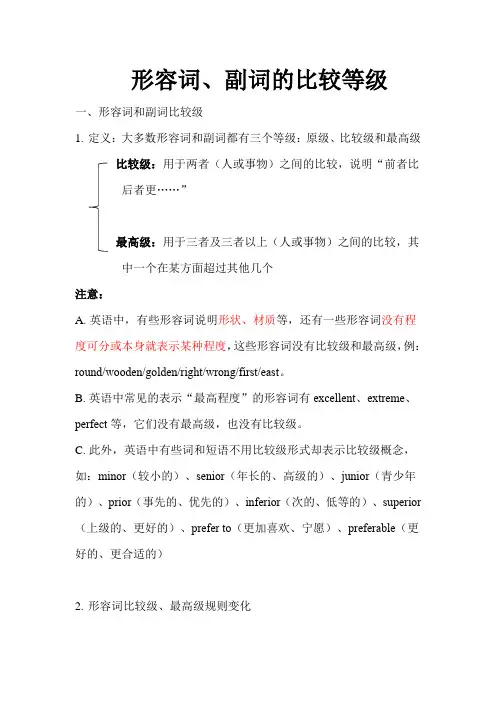
形容词、副词的比较等级一、形容词和副词比较级1.定义:大多数形容词和副词都有三个等级:原级、比较级和最高级比较级:用于两者(人或事物)之间的比较,说明“前者比后者更……”最高级:用于三者及三者以上(人或事物)之间的比较,其中一个在某方面超过其他几个注意:A.英语中,有些形容词说明形状、材质等,还有一些形容词没有程度可分或本身就表示某种程度,这些形容词没有比较级和最高级,例:round/wooden/golden/right/wrong/first/east。
B.英语中常见的表示“最高程度”的形容词有excellent、extreme、perfect等,它们没有最高级,也没有比较级。
C.此外,英语中有些词和短语不用比较级形式却表示比较级概念,如:minor(较小的)、senior(年长的、高级的)、junior(青少年的)、prior(事先的、优先的)、inferior(次的、低等的)、superior (上级的、更好的)、prefer to(更加喜欢、宁愿)、preferable(更好的、更合适的)2.形容词比较级、最高级规则变化注意:多音节或部分双音节词,也可加less(不如、不像)或least eg. I am less outgoing than my sister. 我不如我的姐姐外向。
3.形容词比较级、最高级不规则变化二、形容词和副词原级的用法1.表示A与B在某一方面相同或不同时,用adj/adv的原级,表示两者在某一方面相同时,用“as+adj/adv原级+as”句型;表示一方在某方面不如另一方时,用“not+as/so+adj/adv原级+as”句型。
eg. I think science is as important as math. 我认为科学和数学一样重要。
It is not as/so warm today as yesterday. 今天不如昨天暖和。
He didn`t write as/so carefully as Tom. 他写得不如Tom认真。
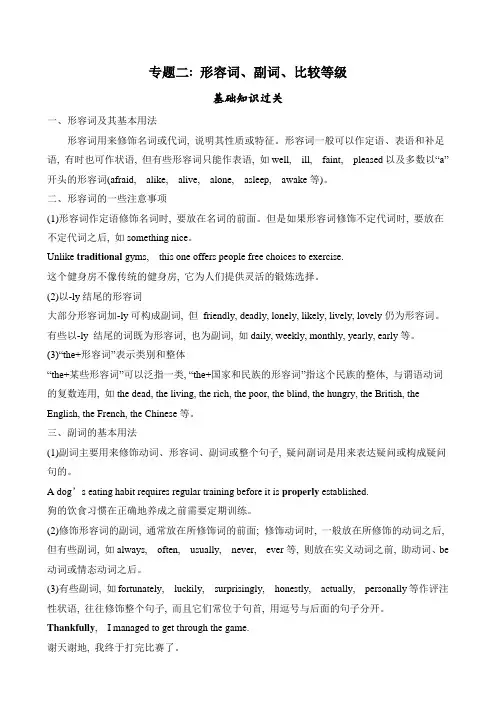
专题二: 形容词、副词、比较等级基础知识过关一、形容词及其基本用法形容词用来修饰名词或代词, 说明其性质或特征。
形容词一般可以作定语、表语和补足语, 有时也可作状语, 但有些形容词只能作表语, 如well, ill, faint, pleased以及多数以“a”开头的形容词(afraid, alike, alive, alone, asleep, awake等)。
二、形容词的一些注意事项(1)形容词作定语修饰名词时, 要放在名词的前面。
但是如果形容词修饰不定代词时, 要放在不定代词之后, 如something nice。
Unlike traditional gyms, this one offers people free choices to exercise.这个健身房不像传统的健身房, 它为人们提供灵活的锻炼选择。
(2)以-ly结尾的形容词大部分形容词加-ly可构成副词, 但friendly, deadly, lonely, likely, lively, lovely仍为形容词。
有些以-ly 结尾的词既为形容词, 也为副词, 如daily, weekly, monthly, yearly, early等。
(3)“the+形容词”表示类别和整体“the+某些形容词”可以泛指一类, “the+国家和民族的形容词”指这个民族的整体, 与谓语动词的复数连用, 如the dead, the living, the rich, the poor, the blind, the hungry, the British, the English, the French, the Chinese等。
三、副词的基本用法(1)副词主要用来修饰动词、形容词、副词或整个句子, 疑问副词是用来表达疑问或构成疑问句的。
A dog’s eating habit requires regular training before it is properly established.狗的饮食习惯在正确地养成之前需要定期训练。

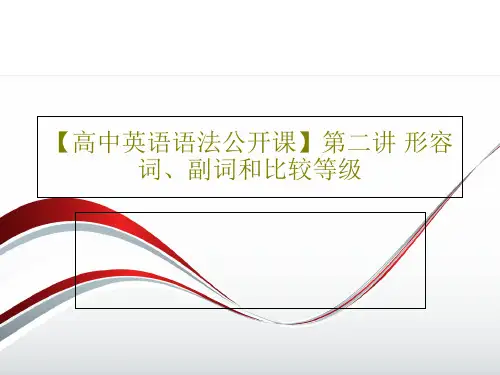

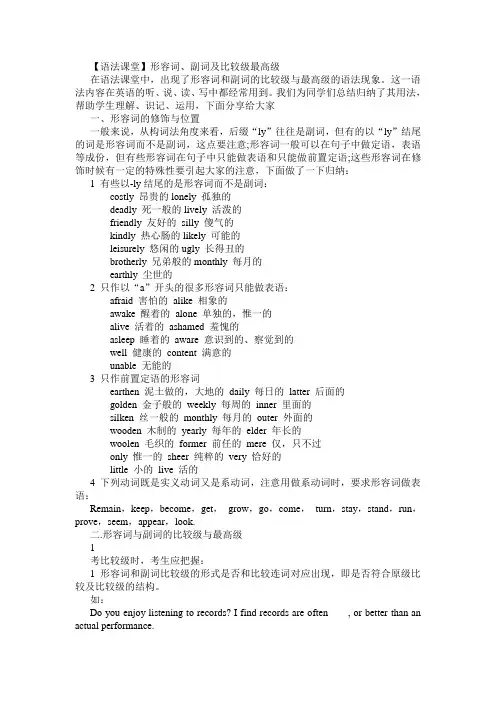
【语法课堂】形容词、副词及比较级最高级在语法课堂中,出现了形容词和副词的比较级与最高级的语法现象。
这一语法内容在英语的听、说、读、写中都经常用到。
我们为同学们总结归纳了其用法,帮助学生理解、识记、运用,下面分享给大家一、形容词的修饰与位置一般来说,从构词法角度来看,后缀“ly”往往是副词,但有的以“ly”结尾的词是形容词而不是副词,这点要注意;形容词一般可以在句子中做定语,表语等成份,但有些形容词在句子中只能做表语和只能做前置定语;这些形容词在修饰时候有一定的特殊性要引起大家的注意,下面做了一下归纳:1 有些以-ly结尾的是形容词而不是副词:costly 昂贵的lonely 孤独的deadly 死一般的lively 活泼的friendly 友好的silly 傻气的kindly 热心肠的likely 可能的leisurely 悠闲的ugly 长得丑的brotherly 兄弟般的monthly 每月的earthly 尘世的2 只作以“a”开头的很多形容词只能做表语:afraid 害怕的alike 相象的awake 醒着的alone 单独的,惟一的alive 活着的ashamed 羞愧的asleep 睡着的aware 意识到的、察觉到的well 健康的content 满意的unable 无能的3 只作前置定语的形容词earthen 泥土做的,大地的daily 每日的latter 后面的golden 金子般的weekly 每周的inner 里面的silken 丝一般的monthly 每月的outer 外面的wooden 木制的yearly 每年的elder 年长的woolen 毛织的former 前任的mere 仅,只不过only 惟一的sheer 纯粹的very 恰好的little 小的live 活的4下列动词既是实义动词又是系动词,注意用做系动词时,要求形容词做表语:Remain,keep,become,get,grow,go,come,turn,stay,stand,run,prove,seem,appear,look.二.形容词与副词的比较级与最高级1考比较级时,考生应把握:1形容词和副词比较级的形式是否和比较连词对应出现,即是否符合原级比较及比较级的结构。

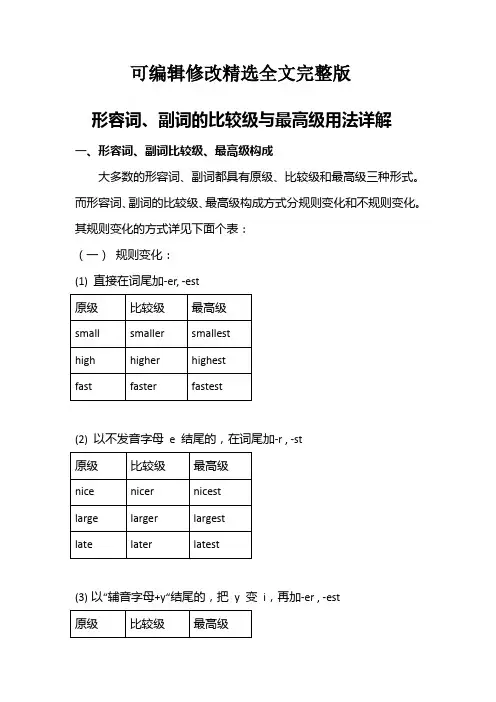
可编辑修改精选全文完整版形容词、副词的比较级与最高级用法详解一、形容词、副词比较级、最高级构成大多数的形容词、副词都具有原级、比较级和最高级三种形式。
而形容词、副词的比较级、最高级构成方式分规则变化和不规则变化。
其规则变化的方式详见下面个表:(一)规则变化:(1) 直接在词尾加-er, -est(2) 以不发音字母e 结尾的,在词尾加-r , -st(3)以“辅音字母+y“结尾的,把y 变i,再加-er , -est(4) 以辅音字母结尾的重读闭音节词汇,双写最后一个辅音字母,再加-er , -est(5) 部分双音节和多音节词,在其前加more, most(二)、不规则变化:比较级、最高级具有不规则变化形式的形容词和副词比较少,因此,需要大家逐一认真记忆。
详见下表:【妙记顺口溜】“坏”“病”两“多”和两“好”,一是“远”来,二是“老”,little 是“少”不是“小”。
二、形容词、副词比较级和最高级用法(一)形容词、副词比较级用法形容词、副词的比较级主要对两个的人或物在某种程度、性质上进行比较。
常见的形容词副词比较级用法如下:1.同级比较① A+be/v+as+原级+as+B A和B一样This room is as large as that one .这间房子和那间一样大(形容词)Tom writes as carefully as Kate.汤姆写字跟凯特一样认真。
(副词)②A+be/V+not+as(so)+级+as +B A 不如BTigers aren't as(so) dangerous as lions.老虎不如狮子危险。
(形容词)Mary didn't finish the work as(so) well as Lucy.玛丽完成这项工作不如露西好。
(副词)2.差极比较①A+be/v+比较级+B A比B更......This pen is newer than that one.这支钢笔比那支新。

一. 形容词、副词的比较级和最高级一.形容词、副词的级:原级,比较级,最高级二.形容词、副词三个级的用法:1.原级比较,和……一样as +原级+as (否定:not so/as …as)eg. They run quite fast. 他们跑得相当快。
Jimmy is as tall as his father. 吉姆和他的爸爸一样高。
He studies as hard as his brother. 他和他哥哥学习一样努力。
2.二者比较时(用比较级),比较级+thaneg. Helen is taller than me/I (am). 海伦比我高。
She runs faster than he (does). 她跑得比他快。
3.the+最高级+(名词)+范围,表示在……中是最……的eg. The dress is the largest in the shop. 这条裙子是店里最大的。
He runs (the) fastest in our class.■不规则变化:两多两好三不好,一老一远加一少(最高级前要用the,副词最高级前面可省略)四.比较级的其他句型结构1. 表示两者之间的选择,可使用“Which/Who+ 谓语动词+比较级, …or …?●Which one is ______________, this one or that one?A. goodB. badC. bestD. worseeg. Which T-shirt is nicer, this one or that one?2. 比较级+and+比较级或more and more +原级,表示越来越……eg. It becomes warmer and warmer when spring comes.It is getting cooler and cooler.Our school is becoming more and more beautiful.● The weather is becoming ______________.A. hotter and hotterB. more hot and hotC. hoter and hoterD. more and more hot● I like Meishan ___________ because it is becoming __________.A. well; beautifulB. better; more and more beautifulC. well; more and more beautifulD. better; beautiful and beautiful●—I talked with my little uncle on the computer last night.--The internet makes the world _________________.A. small and smallB. smaller and smallerC. small and smallerD. smaller and small3. the+比较级,the+比较级,越……,越……eg. The more we get, the happier we feel.The sooner, the better.The harder you work, the better grades you’ll get.● ___________ you’re, __________ mistakes you’ll make.A. The careful, the lessB. The more careful, the lessC. The more carefully, the fewerD. The more careful, the fewer●–The more you practice, ___________ your English will be.-- I agree. Practice makes perfect.A. the betterB. the worseC. moreD. less4.the+比较级+of,表示两者之间较……的一个eg. Nancy and Lucy are twins. In some way they look the same, but Nancy is the taller of the two.5. 比较级+than+ any+ other+名词(单数),表示比其他任何的……都……(比较级的形式表示最高级的含义)eg. He is taller than any other student in his class.=He is the tallest student in his class.他比他班上的任何一个学生都高。
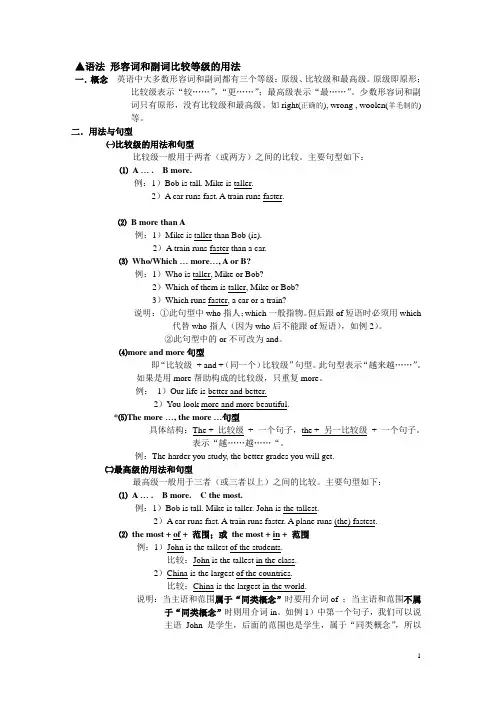
▲语法形容词和副词比较等级的用法一.概念英语中大多数形容词和副词都有三个等级:原级、比较级和最高级。
原级即原形;比较级表示“较……”,“更……”;最高级表示“最……”。
少数形容词和副词只有原形,没有比较级和最高级。
如right(正确的), wrong , woolen(羊毛制的)等。
二.用法与句型㈠比较级的用法和句型比较级一般用于两者(或两方)之间的比较。
主要句型如下:⑴A … . B more.例:1)Bob is tall. Mike is taller.2)A car runs fast. A train runs faster.⑵B more than A例:1)Mike is taller than Bob (is).2)A train runs faster than a car.⑶Who/Which … more…, A or B?例:1)Who is taller, Mike or Bob?2)Which of them is taller, Mike or Bob?3)Which runs faster, a car or a train?说明:①此句型中who指人;which一般指物。
但后跟of短语时必须用which代替who指人(因为who后不能跟of短语),如例2)。
②此句型中的or不可改为and。
⑷more and more句型即“比较级+ and +(同一个)比较级”句型。
此句型表示“越来越……”。
如果是用more帮助构成的比较级,只重复more。
例:1)Our life is better and better.2)You look more and more beautiful.*⑸The more …, the more …句型具体结构:The + 比较级+ 一个句子,the + 另一比较级+ 一个句子。
表示“越……越……“。
例:The harder you study, the better grades you will get.㈡最高级的用法和句型最高级一般用于三者(或三者以上)之间的比较。
形容词,副词I.形容词:形容词修饰名词/代词,说明被修饰的名词代词的特征. II. 1.形容词位置:通常用在名词前,代词后,连系动词后.形容词作定语时通常前置,但在以下情况,形容词必须后置: 1)修饰合成不定代词,something, anyone 等.There is nobody absent today.2)以-able /-ble 结尾的形容词可置于形容词最高级或only 修饰的名词后.如: That is the only solution possible . 3)成对的形容词可后置,常用逗号给开.There was a large room, simple and beautiful. 4)当“形容词+介词/不定式”构成的短语作定语时后置.The teacher asked me a question t oo difficult to answer . A man so difficult to please must be hard to work with. 5)当old, long, high, wide, deep 等词附有数量词短语作定语时后置.At that time she was only a girl five years old. I have once seen a snake about a meter long .Exp. 1. - Is there anything new in today’ s newspaper? - No,(没有新内容).2. - I have no (可用的房间)for you.3. People in the village,(老的和少的), men and women, are fond of singing and dancing.4. She saw a man (大约两米高的).2 .有些形容词既可以做前置定语也可以做后置定语,但意思不同,要注意区分.常见的有:the responsible man (可依赖的) the man responsible (应负责的) the present members (现在的) the members present (在场的) the absent students (心不在焉的) the students absent (缺席的) the concerned teachers (忧心忡忡的)the teachers concerned (有关的)3 .表语形容词:常见的表语形容词有(主要是以a-开头的词):asleep, awake, alike, afraid, alive, alone, glad, ready, sorry, sure, ill, well (指健康状况好),ashamed, afloat (漂浮不定的),worth 等,它们除了做表语外还可以 做宾语补足语,但不能做前置定语.如:That cat is ill. That is a ill cat.(错)That is a sick cat (正确). That is an asleep baby.(错) That is a sleeping baby.(正确). He fell asleep in a short while.(正确).The driver was found alive after the terrible traffic accident. She was the only person awake that night. 4 .形容词的搭配:形容词与介词的搭配不同,其后要求接的对象也不同,甚至意思也有所不同,有的搭配是固定的,构成短语后的作用相 当于一个动词,如:be strict with sbbe pleased with sb be friendly to be interested in be excited at/about be thankful to sb be careful of get/be tired ofmuch afraidIII.形容词的由来:除自然形容词外,部分形容词可以在名词尾加上适当的词缀变成形容词,如:care - careful fun --funny sun - sunny difference - difference 附,名词变形容词的规则: 1. + y a. cloud - cloudy b. sun - sunnyc. noise - noisybe strict in sth be afraid ofbe angry with sth sb /at sth be surprised/ amazed at be disappointed at be familiar withbe sure / certain of 其他搭配:blind /dead dunk fast sleepmuch alike2.+ ful care - careful help - helpful3.friend - friendly sister - sisterly4.importance - important difference - different patience - patient5.+ -less (无) care - careless price - priceless注意:un- im- in- -less (均表示“不/无”...)等不改变词性,但词义相反,如:happy - un happy comfortable - un comfortable expensive - in expensivepolite - im polite possible - im possible* 6. difficulty -- difficult honest y -- honest anger - angry hunger - hungry 有些形容词还可以由动词+ -ing / -ed变来,如:come - coming die - dying interest - interesting surprise - surprisingworry - worried disappoint - disappointed convince -convincedExercises 1将下列名词变成形容词:wind rain snow funimportance difficulty difference thankuse care beauty helpnoise sun health tasteprice (无价的)home (无家可归的)use (无用的)live care (粗心的)lovebrother honesty help(无助的)hungerIV.副词1. 副词主要修饰动词,very,_quite,_really,_pretty,_rather,_terribly (很,可怕地)等也可以修饰形容词和别的副词。